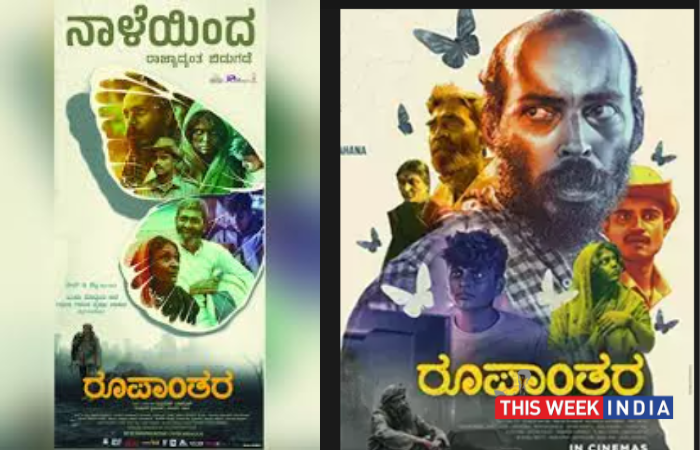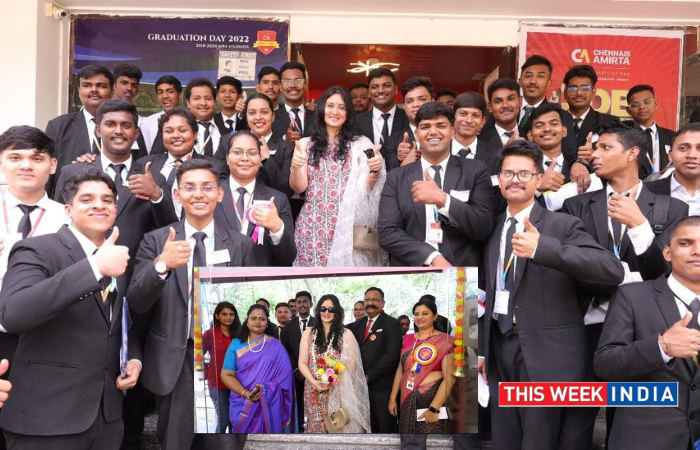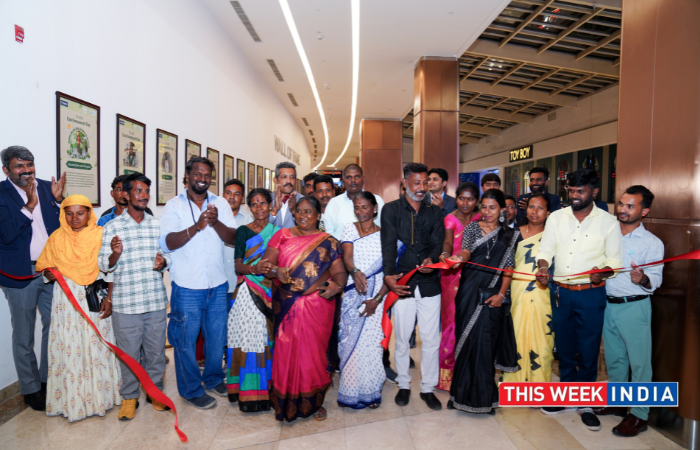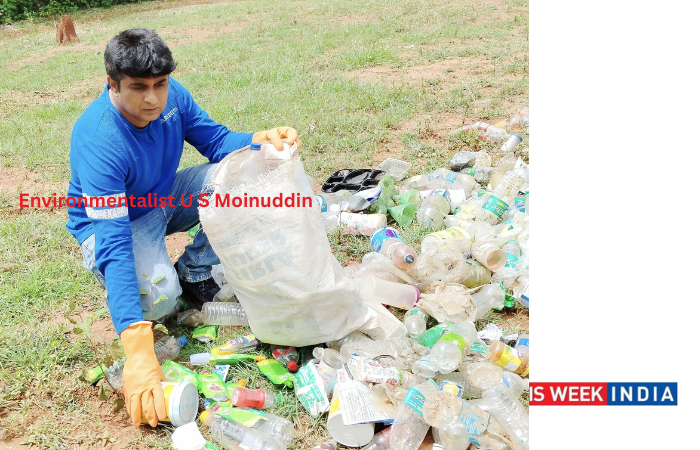KS Muralidharan
In the realm of contemporary cinema, few debuts manage to make an indelible impact quite like Mithilesh Edavalath’s Roopanthara. This Kannada film offers a stark, thought-provoking vision of a dystopian future where clean air is a rare commodity, and storytelling itself becomes a crucial means of survival. The film’s inventive approach intertwines multiple narratives, providing a rich tapestry of human experience that explores themes of transformation, redemption, and the quest for meaning in an unforgiving world.
A Dystopian Framework: The Storyteller’s Plight
At the outset, the viewer’s curiosity is stoked with a gripping and unsettling scene: an old man, portrayed with depth and gravitas by Raj B Shetty, is held at gunpoint and forced to narrate stories to avoid execution. This framing device not only sets the tone for the film but also establishes a unique narrative structure. The old man’s role as a storyteller in this bleak, dystopian future serves as a metaphor for the fragile nature of hope and the power of narrative to both reflect and shape reality.
This storytelling framework is crucial as it introduces the film’s central apparatus – four distinct yet interconnected stories that reflect various facets of societal breakdown and personal struggle. As the old man recounts these tales, the audience is transported into a world where survival hinges on the ability to craft compelling stories, a concept that underscores the film’s exploration of the human condition in extreme circumstances.
The Metaphor of Transformation
At the core of Roopanthara is a powerful metaphor: the transformation of a worm into a butterfly. This imagery, introduced through the old man’s storytelling, symbolizes the potential for change and the harsh reality that not all transformations lead to success. The butterfly’s metamorphosis becomes a lens through which the film examines the characters’ journeys and the broader theme of human evolution in the face of adversity.
The Goon and the Corporate Clash
One of the film’s standout segments is the confrontation between the goon, played with raw intensity by Raj B Shetty, and a young IT professional. Their conflict, which begins over a seemingly trivial issue, quickly escalates into a tragic confrontation. This story highlights the futility of violence and the deep-seated personal demons that drive individuals to destructive behaviour.
The scene where the goon and the IT professional clash is particularly notable for its intensity and the way it encapsulates the film’s themes. The confined space of the altercation amplifies the sense of chaos and pain, reflecting the broader societal tensions that permeate the narrative. The goon’s journey from aggression to vulnerability is a powerful representation of the film’s exploration of transformation and redemption.
The Aging Couple’s City Sojourn
Another poignant storyline follows an elderly couple from north Karnataka, played by Somshekhar Bolegaon and Hanumakka, who travel to Bengaluru to fulfill a long-held dream. Their journey, initially marked by tenderness and warmth, takes a darker turn as they encounter the harsh realities of urban life. Their story is a moving exploration of aging, the unfulfilled dreams of youth, and the often indifferent nature of modern cities.
The couple’s interactions, filled with genuine affection and nostalgia, provide a stark contrast to the cruel and often dehumanizing aspects of city life they encounter. The narrative delves into themes of loss, isolation, and the struggle to maintain one’s dignity in an unforgiving environment. Despite the emotional depth of the story, the film occasionally veers into melodrama, which can detract from its impact. Nevertheless, the performances of Bolegaon and Hanumakka are deeply affecting, capturing the essence of their characters’ vulnerability and resilience.
The Misjudged Beggar
The segment featuring Lekha Naidu as a beggar wrongfully accused of child theft stands out for its intense emotional impact and social commentary. Naidu’s portrayal of the beggar, who is caught in a web of societal judgment and systemic flaws, is both compelling and heart-wrenching. Her performance, despite limited dialogue, communicates a profound sense of desperation and dignity.
The story is further enriched by the character of a young, conflicted police constable, played by Bharath G B, who is caught in a moral quagmire. The tension between his professional obligations and his personal sense of justice adds depth to the narrative. This segment resonates with a sense of realism reminiscent of Iranian cinema, drawing viewers into a poignant exploration of social justice and human empathy.
The Drug-Addicted Teen
The final storyline follows a teenager, portrayed with haunting authenticity by Anjan Bharadwaj, who is ensnared by addiction and an ominous online game. This segment reflects the darker aspects of escapism and the destructive paths young people may take in a dystopian world. Bharadwaj’s performance is particularly noteworthy for its emotional depth and the visceral portrayal of addiction.
While the story begins with a strong premise, it struggles to maintain coherence as it ties into the larger narrative. The resolution, which triggers a new chain of events, can feel somewhat convoluted. Nevertheless, the segment offers a powerful commentary on the impact of modern technology and the challenges faced by the younger generation in navigating a complex and often hostile world.
Cinematic Craft and Performances
Roopanthara is distinguished by its strong performances and cinematic craftsmanship. Raj B Shetty’s dual role as both actor and dialogue writer adds a layer of authenticity and intensity to the film. His portrayal of the goon is both commanding and vulnerable, creating a character caught in a web of moral ambiguity.
Anjan Bharadwaj’s portrayal of the drug-addicted teen is reminiscent of intense performances in films like Requiem for a Dream, where the protagonist’s struggles are depicted with visceral honesty.
The cinematography by Praveen Sriyan and the evocative score by Midhun Mukundan enhance the film’s atmosphere. Sriyan’s use of CGI to depict the dystopian setting is visually striking, capturing the bleakness and despair of the future world.
An Inventive and Immersive Experience
The most compelling segments are those that manage to balance emotional depth with realism, such as the goon’s conflict and the drug addict’s internal conflicts. These stories are effective in drawing viewers into their respective dilemmas and providing insightful commentary on societal issues.
Roopanthara excels in its ambition to explore complex themes such as transformation, redemption, and the human struggle in a dystopian world. The film’s approach to intertwining narratives and its use of the butterfly metaphor are innovative and thought-provoking.
The film’s strength lies in its ability to provoke thought and elicit empathy from its audience. While the resolution of some storylines may leave viewers seeking more closure, the thematic depth and the character arcs offer a rewarding viewing experience. Mithilesh Edavalath’s debut is a testament to his potential as a storyteller, and his bold vision for Roopanthara paves the way for more inventive voices in Kannada cinema.
In summary, Roopanthara is a thought-provoking and ambitious film that combines powerful performances with a richly woven narrative about transformation and redemption. For those who appreciate films that challenge conventions and provoke deep reflection, Roopanthara offers a compelling and resonant journey through a dystopian lens. Mithilesh Edavalath, with his innovative approach and a talented cast, has crafted a film that not only entertains but also invites viewers to ponder the complexities of human nature and societal evolution.









